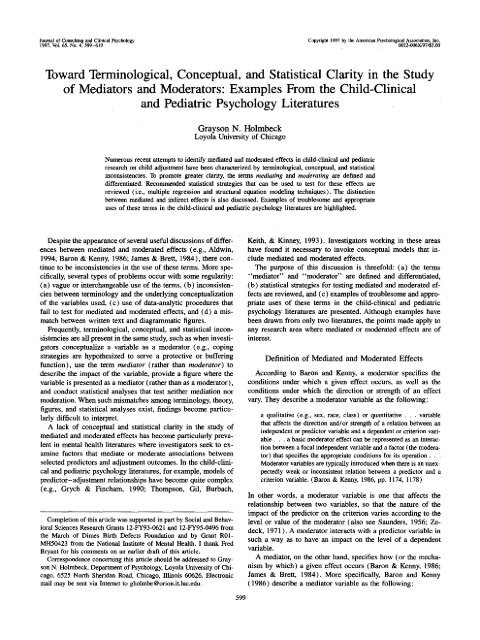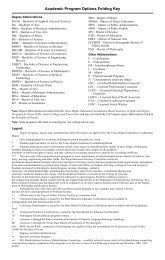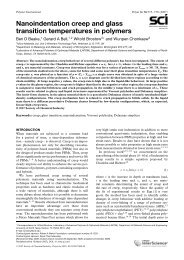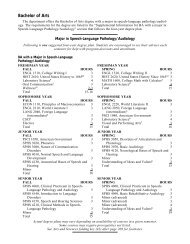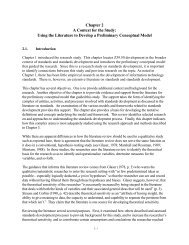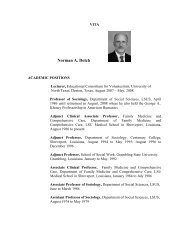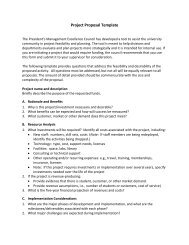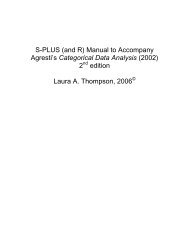Holmbeck, G. N. (1997). - Personal.kent.edu
Holmbeck, G. N. (1997). - Personal.kent.edu
Holmbeck, G. N. (1997). - Personal.kent.edu
- No tags were found...
Create successful ePaper yourself
Turn your PDF publications into a flip-book with our unique Google optimized e-Paper software.
Journal of Consulting and Clinical PsychologyCopyright <strong>1997</strong> by the American Psychological Association, Inc.<strong>1997</strong>, Vol. 65, No. 4, 599-610 0022-006X/97/$3.00Toward Terminological, Conceptual, and Statistical Clarity in the Studyof Mediators and Moderators: Examples From the Child-Clinicaland Pediatric Psychology LiteraturesGrayson N. <strong>Holmbeck</strong>Loyola University of ChicagoNumerous recent attempts to identify mediated and moderated effects in child-clinical and pediatricresearch on child adjustment have been characterized by terminological, conceptual, and statisticalinconsistencies. To promote greater clarity, the terms mediating and moderating are defined anddifferentiated. Recommended statistical strategies that can be used to test for these effects arereviewed (i.e., multiple regression and structural equation modeling techniques). The distinctionbetween mediated and indirect effects is also discussed. Examples of troublesome and appropriateuses of these terms in the child-clinical and pediatric psychology literatures are highlighted.Despite the appearance of several useful discussions of differencesbetween mediated and moderated effects (e.g., Aldwin,1994; Baron & Kenny, 1986; James & Brett, 1984), there continueto be inconsistencies in the use of these terms. More specifically,several types of problems occur with some regularity:(a) vague or interchangeable use of the terms, (b) inconsistenciesbetween terminology and the underlying conceptualizationof the variables used, (c) use of data-analytic proc<strong>edu</strong>res thatfail to test for mediated and moderated effects, and (d) a mismatchbetween written text and diagrammatic figures.Frequently, terminological, conceptual, and statistical inconsistenciesare all present in the same study, such as when investigatorsconceptualize a variable as a moderator (e.g., copingstrategies are hypothesized to serve a protective or bufferingfunction), use the term mediator (rather than moderator) todescribe the impact of the variable, provide a figure where thevariable is presented as a mediator (rather than as a moderator),and conduct statistical analyses that test neither mediation normoderation. When such mismatches among terminology, theory,figures, and statistical analyses exist, findings become particularlydifficult to interpret.A lack of conceptual and statistical clarity in the study ofmediated and moderated effects has become particularly prevalentin mental health literatures where investigators seek to examinefactors that mediate or moderate associations betweenselected predictors and adjustment outcomes. In the child-clinicaland pediatric psychology literatures, for example, models ofpredictor-adjustment relationships have become quite complex(e.g., Grych & Fincham, 1990; Thompson, Gil, Burbach,Completion of this article was supported in part by Social and BehavioralSciences Research Grants 12-FY93-0621 and 12-FY95-0496 fromthe March of Dimes Birth Defects Foundation and by Grant R01-MH50423 from the National Institute of M~ntal Health. I thank FredBryant for his comments on an earlier draft of this article.Correspondence concerning this article should be addressed to GraysonN. <strong>Holmbeck</strong>, Department of Psychology, Loyola University of Chicago,6525 North Sheridan Road, Chicago, Illinois 60626. Electronicmail may be sent via Internet to gholmbe@orion.it.luc.<strong>edu</strong>.Keith, & Kinney, 1993). Investigators working in these areashave found it necessary to invoke conceptual models that ineludemediated and moderated effects.The purpose of this discussion is threefold: (a) the terms"mediator" and "moderator" are defined and differentiated,(b) statistical strategies for testing mediated and moderated effectsare reviewed, and (c) examples of troublesome and appropriateuses of these terms in the child-clinical and pediatricpsychology literatures are presented. Although examples havebeen drawn from only two literatures, the points made apply toany research area where mediated or moderated effects are ofinterest.Definition of Mediated and Moderated EffectsAccording to Baron and Kenny, a moderator specifies theconditions under which a given effect occurs, as well as theconditions under which the direction or strength of an effectvary. They describe a moderator variable as the following:a qualitative (e.g., sex, race, class) or quantitative . . . variablethat affects the direction and/or strength of a relation between anindependent or predictor variable and a dependent or criterion variable...,a basic moderator effect can be represented as an interactionbetween a focal independent variable and a factor (the moderator)that specifies the appropriate conditions for its operation...Moderator variables are typically introduced when there is an unexpectedlyweak or inconsistent relation between a predictor and acriterion variable. (Baron & Kenny, 1986, pp. 1174, 1178)In other words, a moderator variable is one that affects therelationship between two variables, so that the nature of theimpact of the predictor on the criterion varies according to thelevel or value of the moderator (also see Saunders, 1956; Zedeck,1971 ). A moderator interacts with a predictor variable insuch a way as to have an impact on the level of a dependentvariable.A mediator, on the other hand, specifies how (or the mechanismby which) a given effect occurs (Baron & Kenny, 1986;James & Brett, 1984). More specifically, Baron and Kenny(1986) describe a mediator variable as the following:599
600 HOLMBECKthe generative mechanism through which the focal independent variableis able to influence the dependent variable of interest . . .(and) Mediation... is best done in the case of a strong relationbetween the predictor and the criterion variable. (pp. 1173, 1178)Stated more simply, "the independent variable causes the mediatorwhich then causes the outcome" (Shadish & Sweeney, 1991,p. 883). Although one may argue that the relationships amongindependent variable, mediator, and outcome may not necessarilybe "causal," the nature of the mediated relationship is suchthat the independent variable influences the mediator which, inturn, influences the outcome. Also critical is the prerequisitethat there be a significant association between the independentvariable and the dependent variable before testing for a mediatedeffect.Mediators and moderators can also be differentiated diagrammatically(see Figure 1; see also Baron & Kenny, 1986; Cohen &Cohen, 1983). A mediator (B in the top model in Figure 1)falls in the causal pathway between two variables (A and C inthe top model in Figure 1; James & Brett, 1984); that is, ifAis significantly associated with C, and if A influences B and Binfluences C, then B is a mediating variable between A and C(more detailed criteria are discussed later). On the other hand,if A is expected to be related to C, but only under certainconditions of B, then B is a moderator variable (see the bottommodel in Figure 1 ). The moderator (B) can be drawn to indicatethat it has an impact on the relationship between A and C.Although some variables are more likely to be moderators thanmediators (e.g., gender), some variables could serve either function,depending on the conceptual model under investigation(although not in the same analysis; see Lewis & Kliewer, 1996;Quittner, Glueckauf & Jackson, 1990; Sandier, Tein, & West,1994, for examples where coping strategies or social supportwere tested as both mediators and moderators in competingmodels). Moreover, both moderators and mediators can be specifiedwithin the same model (e.g., moderated mediation;James & Brett, 1984; for examples of this strategy, see Harnish,Dodge, & Valente, 1995; <strong>Holmbeck</strong>, 1996; Simons, Lorenz,Wu, & Conger, 1993).An example illustrates the distinction between moderated andAfB' CA ,CTBFigure 1. Models of mediated and moderated effects. In the top model,B mediates the relationship between A and C. In the bottom model, Bmoderates the relationship between A and C.mediated effects. This example is based on Fauber, Forehand,Thomas, and Wierson's (1990) study of marital conflict andadolescent adjustment in intact and divorced families. To examinethe processes by which marital conflict has a negative influenceon child adjustment, Fauber and his colleagues hypothesizedthat marital conflict has a negative impact on the qualityof parenting to which a child is exposed which, in turn, has animpact on child adjustment. In this case, parenting quality is apotential mediator of the conflict --* adjustment relationship andis predicted to account (at least partially) for this relationship.Alternatively, if one sought to test the hypothesis that the conflict--* adjustment relationship would hold only for divorced familiesand would not hold for intact families, then one would be studyingwhether family structure (i.e., intact vs. divorced) moderatesassociations between marital conflict and child adjustment.Statistical Strategies for Testing Moderated EffectsFor both moderated and mediated effects, two types of statisticalstrategies are discussed: multiple regression (as reviewedby Baron & Kenny, 1986, and as used by several investigators)and structural equation modeling (SEM; see Tabachnick & Fidell,1996, for a relatively straightforward discussion; also seeBollen, 1989; Byrne, 1994; Hoyle, 1995; Jaccard & Wan, 1996;Mueller, 1996). Although SEM is often considered the preferredmethod because of the information that it provides on the degreeof "fit" for the entire model after cbntrolling for measurementerror (Peyrot, 1996), proper use of regression techniques canalso provide meaningful tests of hypotheses. Moreover, for investigatorsworking in the area of pediatric psychology, wheresample Ns are often relatively small, use of regression techniques(as opposed to SEM) may be necessary because of powerconsiderations (see Tabachnick & Fidell, 1996, for a discussionof sample size and SEM). Although regression strategies maybe more familiar to many readers of this journal, user-friendlyversions of SEM software are now available (e.g., EQS; Bentler,1995; although Jaccard & Wan, 1996, argue that LISREL 8,Jtreskog & StJrbom, 1993, is currently the preferred softwarewhen attempting to analyze the significance of interaction effectsbecause EQS does not permit nonlinear constraints amongparameters).Regression Approach to Testing Moderated EffectsAlthough the manner in which moderators are tested statisticallyvaries somewhat depending on whether the predictor andmoderator are continuous or dichotomous (Baron & Kenny,1986; Mason, Tu, & Cauce, 1996), the general strategy is thesame regardless of the nature of the variables involved. As notedearlier, a moderator effect is an interaction effect. The preferredstrategy is to use the variables in their continuous form (if theyare not dichotomies) and to use multiple regression techniques(Cohen & Cohen, 1983; Cohen & Wills, 1985; Jaccard, Turrisi,& Wan, 1990; James & Brett, 1984; Mason et al., 1996).The predictor and moderator main effects (and any covariates,if applicable) are entered into the regression equation first, followedby the interaction of the predictor and the moderator (e.g.,Fuhrman & <strong>Holmbeck</strong>, 1995). Depending on the investigator'sconceptual framework, the main effects can be entered in ahierarchical, stepwise, or simultaneous fashion (Cohen & Co-
MEDIATORS AND MODERATORS 601hen, 1983). For example, in analyses involving marital conflictas a predictor and family structure as a moderator, marital conflictand family structure could be entered in any order or simultaneously.The interaction term is represented by the product ofthe two main effects (e.g., Marital Conflict × Family Structure)and "only becomes the interaction when its constituent elementsare partialled" (Cohen & Cohen, 1983, p. 305; see also Aiken &West, 1991; Evans, 1991; Friedrich, 1982; <strong>Holmbeck</strong>, 1989).Thus, although the main effects may be entered in any order,they must be entered before the interaction term for the productof these two terms to represent the interaction when it entersthe equation.Given the manner in which the interaction is computed, themain effects (i.e., the predictor and the moderator) will behighly correlated with the interaction term, which can produce"ill-conditioning" error messages when using some statisticalsoftware packages. To eliminate problematic multicollinearityeffects between first-order terms (i.e., the independent variableand the moderator) and the higher order terms (i.e., the interactionterms), Aiken and West ( 1991 ) have recommended that theindependent variable and the moderator be "centered" beforetesting the significance of the interaction term. To center a variable,scores are put into deviation score form by simply subtractingthe sample mean from all individuals' scores on thevariable, thus producing a revised sample mean of zero. Suchtransformations have no impact on the level of significance ofthe interaction terms or the simple slopes of any plotted regressionlines.Statistically significant interactions are interpreted by plottingsimple regression lines for high and low values of the moderatorvariable (Aiken & West, 1991; Cohen & Cohen, 1983; James &Brett, 1984; for recent examples with data tables or figures, seeBrody, Stoneman, & Gauger, 1996; Colder, Lochman, & Wells,in press; Fuhrman & <strong>Holmbeck</strong>, 1995; Silverberg, Marczak, &Gondoli, 1996; Wagner, Cohen, & Brook, 1996). To plot regressionlines, an equation is used that includes terms for the covariates(if applicable), the two main effects (e.g., marital conflictand family structure), and the interaction term (e.g., MaritalConflict x Family Structure), along with the correspondingunstandardized regression coefficients and the y intercept (Aiken& West, 1991; Cohen & Cohen, 1983; <strong>Holmbeck</strong>, 1989).By substituting into this equation all possible combinations ofhigh (e.g., M + 1 SD) and low (e.g., M - 1 SD) values of thepredictor and the moderator (i.e., high-high, low-low, high-low,and low-high), two regression lines can be generated wherepredicted values of the dependent variable are plotted (e.g.,Fuhrman & <strong>Holmbeck</strong>, 1995). Also, as carefully explained byAiken and West (1991), investigators can test the significanceof the slopes for these simple regression lines (e.g., Colder,Lochman, & Wells, in press; Silverberg et al., 1996; Wagner etal., 1996; although, in some cases, associations between thepredictor and the dependent variable may be curvilinear; Molina& Chassin, 1996). In the case of categorical moderatorvariables, high and low values are represented by the two dichotomousdummy values for this variable. With respect to covariates,the means can be substituted for these terms in the equation(which are multiplied by their corresponding regressionweights). This strategy for including covariates should only beused, however, if the investigator has tested for the presence ofsignificant interaction effects between the covariates and independentvariables and found them to be nonsignificant.As a caution to the reader, it is worth noting that significantmoderator effects may be difficult to detect statistically. Thisdifficulty is most likely to occur in studies where samples arerelatively homogeneous because all high and low values of themoderator and predictor may not be adequately represented (seeMcClelland & Judd, 1993, for a complete discussion of thisissue). Also, unreliability of measurement in the main effectsis compounded once a multiplicative term is computed (seeJaccard & Wan, 1995, for suggestions on how to examine andtake into account such unreliability when conducting statisticalanalyses).SEM Approach to Testing Moderated EffectsBecause of the problem of compounding of measurementerror when computing interaction terms, several authors havemaintained that SEM strategies provide a less biased assessmentof the significance of moderator effects (e.g., Jaccard & Wan,1996; Peyrot, 1996; Ping, 1996). In fact, regression strategiestend to underestimate the effect size of the interaction term,particularly as measurement error in the predictor and moderatorvariable increases (Jaccard & Wan, 1996; Peyrot, 1996). TheSEM strategy is also preferred when the investigator has morethan one measured variable for each of the constructs (or latentvariables) assessed.The logic behind testing the significance of interaction effectswith SEM designs is relatively straightforward, particularlywhen the moderator is a dichotomous variable (Jaccard & Wan,1996; Ping, 1996). Suppose that one is interested in whetherthe association between a latent predictor variable (which isassessed with more than one measured variable) and a latentcriterion variable (which is also assessed with more than onemeasured variable) vary as a function of gender. To test for thepresence of moderation, one assesses the overall fit of the modelunder two conditions: (a) when there are no constraints on thesolution (i.e., when the relationship between the predictor andcriterion variables can vary as a function of gender) and (b)when the association between the predictor and criterion variablesis constrained to be equal (i.e., an equality constraint) forthe two genders (see Farrell, 1994; Jaccard & Wan, 1996, formore in-depth treatments of this data-analytic technique; seeSimons et al., 1993, for an empirical example). The effect ofthis constraint is to test a model where no Predictor x Genderinteraction is present. One can then calculate and test the significanceof the difference between the goodness-of-fit chisquarevalues for the two models. Unlike other data-analyticstrategies, nonsignificant (i.e., lower) chi-square values are indicativeof a better fit. The magnitude of the difference betweenchi-square values determines the degree to which an interactioneffect is present; that is, if there is a significant deterioration inmodel fit when evaluating the model under the constraint of thesecond condition (an assumption of no interaction), this wouldindicate that a significant interaction is present.When the predictor, criterion, and moderator are all continuous,the analyses are more complex. On initial inspection, one mayassume that all possible products of the measured indicators couldbe computed as indicators of a latent interaction variable (e.g.,there would be 25 such interaction indicators if the moderator
602 HOLMBECKand predictor latent variables were each assessed with 5 indicators).On the other hand, J6reskog and Yang (1996) and Jaccardand Wan (1996) have maintained that fewer terms are needed butthat several constraints must be imposed to test the significanceof the interaction effect (a complete discussion of interactionsinvolving continuous variables is beyond the scope of this article;see Jaccard & Wan, 1996, for a discussion of these issues, aswell as programming examples using LISREL 8).Statistical Strategies for Testing Mediated EffectsAs was done for moderated effects, both regression and SEMstrategies for testing mediated effects are discussed here.Regression Approach to Testing Mediated EffectsAccording to Baron and Kenny (1986), four conditions mustbe met for a variable to be considered a mediator: (a) thepredictor, A, must be significantly associated with the hypothesizedmediator, B (letters refer to variables in Figure 1 ), (b) thepredictor, A, must be significantly associated with the dependentmeasure, C, (c) the mediator, B, must be significantly associatedwith the dependent variable, C, and (d) the impact of the predictor,A, on the dependent measure, C, is less after controllingfor the mediator, B. ~ A corollary of the second condition isthat there first has to be a significant relationship between thepredictor and the dependent variable for a mediator to serve itsmediating role. In other words, if A and C are not significantlyassociated, there is no significant effect to mediate. Such abivariate association between A and C is not required in thecase of moderated effects (nor is it required in the case on anindirect effect, as discussed later).The four conditions can be tested with three multiple regressionanalyses (see Eckenrode, Rowe, Laird, & Brathwaite, 1995,for an example that includes figures as well as a completeexplanation of this data-analytic strategy). This strategy is similarto that used when conducting a path analysis (Cohen &Cohen, 1983; Nie, Hull, Jenkins, Steinbrenner, & Bent, 1975).The significance of the A --* B path (in the direction predicted;Condition 1 above) is examined in the first regression, aftercontrolling for any covariates. The significance of the A ~ Cpath (Condition 2) is examined in the second regression. Finally,A and B are used as predictors in the third equation whereC is the dependent variable. Baron and Kenny (1986) haverecommended using simultaneous entry (rather than hierarchicalentry) in this third equation, so that the effect of B on C isexamined after A is controlled and the effect of A on C isexamined after B is controlled (borrowing from path-analyticmethodology; Nie et al., 1975). The significance of the B ~ Cpath in this third equation is a test of Condition 3. The relativeeffect of A on C in this equation (when B is controlled), incomparison with the effect of A on C in the second equation(when B is not controlled), is the test of Condition 4. Specifically,A should be less highly associated with C in the thirdequation than was the case in the second equation. As Baronand Kenny (1986) discussed, it would be unusual in psychologyfor this A ---, C effect to be r<strong>edu</strong>ced from significance to zero.Thus, the degree to which the effect is r<strong>edu</strong>ced (e.g., the changein regression coefficients) is an indicator of the potency of themediator. Moveover, the significance of the indirect effect canbe tested (Baron & Kenny, 1986). The reader should note,however, that Baron and Kenny's (1986) discussion of Sobel's(1982) significance test only includes an equation that determinesthe estimated standard error of the indirect effect. A recentarticle by Sobel ( 1988, p. 56) includes a more complete explanationof how to apply the significance test and compute confidenceintervals for the indirect effect (see also Colder, Chassin,Stice, & Curran, in press; Ireys, Werthamer-Larsson, Kolodner,& Gross, 1994; Lustig, Ireys, Sills, & Walsh, 1996, forempirical examples).SEM Approach to Testing Mediated EffectsThe logic for using SEM to test for mediated effects is similarto that discussed earlier for moderated effects involving a dichotomousmoderator. Again, the SEM strategy is particularlyuseful when one has multiple indicators for the latent variablesunder investigation.Assuming that there is a latent predictor variable (A), anhypothesized latent mediator variable (B), and a latent outcomevariable (C), one would first assess the fit of the direct effect(A ~ C) model (Hoyle & Smith, 1994). Assuming an adequatefit, the investigator than tests the fit of the overall A ~ B --, Cmodel. Assuming that the overall model provides an adequatefit, the A ~ B and B ~ C path coefficients are examined. Atthis point, the A ~ C, A ~ B, and B --* C paths (as well as theA ~ B --' C model) should all be significant in the directionspredicted (which is analogous to the regression strategy discussedabove).The final step in assessing whether there is a mediationaleffect is to assess the fit of the A ~ B ~ C model under twoconditions: (a) when the A --* C path is constrained to zero, and(b) when the A ~ C path is not constrained. One then examineswhether the second model provides a significant improvementin fit over the first model. As noted earlier, improvement in fitis assessed with a significance test on the basis of the differencebetween the two model chi-squares. If there is a mediationaleffect, the addition of the A ~ C path to the constrained modelshould not improve the fit. In other words, the previously significantA ~ C path is r<strong>edu</strong>ced to nonsignificance (i.e., it doesnot improve the fit of the model) when the mediator is takeninto account (which is, again, analogous to the regression approach).It is also useful at this point to report and comparethe A ~ C path coefficients for when B is, versus when B isnot, included in the model.An additional consideration in using SEM to test for mediationaleffects is the important distinction between indirect andmediated effects. An example is used to highlight this distinction.Capaldi, Crosby, and Clark (1996) recently conducted anEQS-based longitudinal study, where they concluded that theeffect of aggression in the family of origin on aggression inyoung adult intimate relationships was mediated by the level ofboys' antisocial behaviors during adolescence. On the otherhand, Capaldi and her colleagues appear to have found that theAlthough Baron and Kenny (1986) list three conditions of mediation(rather than four), their third condition actually contains two subconditions:the predictor.(A) must be significantly associated with the outcome(C), and this association must be less after controlling for the mediator(B).
MEDIATORS AND MODERATORS 603direct path between the predictor and criterion was not significant(i.e., all eight correlations between the measured variablesfor the predictor and the measured variables for the criterionwere nonsignificant), despite the fact that the predictor --* mediatorand mediator --* criterion paths were significant. Althoughthere is evidence for an indirect effect between predictor andcriterion, the findings suggest that the mediator does not (andcannot) significantly "account" for the predictor --* criterionrelationship (because there was not a significant relationshipbetween predictor and criterion in the first place; Hoyle & Smith,1994). Thus, Capaldi et al.'s (1996) findings fit the criteria foran indirect effect but do not fit the criteria for a mediated effect(as defined here). In the case of such an indirect effect, onemust be conservative when discussing interpretations of linksbetween predictor and criterion because one cannot claim thatthe predictor and criterion are significantly associated.It is relatively commonplace for investigators who use SEMto claim support for a mediational model, when they have onlytested the significance of and found support for an indirectpathway. Statistical textbooks (e.g., Tabaehnick & Fidell, 1996)also use "mediational pathway" and "indirect pathway" interchangeably.As noted earlier, it is critical to test whether thedirect path between predictor and criterion is significant(Hoyle & Smith, 1994) and, if so, whether this previously significantdirect pathway fails to improve the fit of the mediationalmodel.Inconsistencies in the Testing of Mediation andModeration: Examples from the Pediatric andChild-Clinical Psychology LiteraturesResearchers in the area of pediatric psychology have notedthat most chronic illnesses and physical disabilities require ongoingmedical management and place considerable physical,psychological, and social demands on the individuals and familiesinvolved (e.g., Quittner, 1992). It is also the case, however,that there is considerable variability in the degree to whichchildren and their families exhibit higher levels of adjustmentdifficulties (Thompson et al., 1993). The fact that there is suchvariability has led several investigators to suggest mechanismsthat buffer (or exacerbate) the impact of illness on adjustmentoutcomes (e.g., coping resources, family functioning, illnessappraisal; Thompson et al., 1993; Thompson & Gustafson,1996; Wallander & Thompson, 1995). Similarly, child-clinicalpsychologists have long been interested in the child adjustmentoutcomes of various stressors as well as factors which accountfor such stressor --, outcome associations. One such stressor;marital conflict, has received considerable theoretical and empiricalattention (e.g., Cummings, Davies, & Simpson, 1994;Grych & Fincham, 1990; O'Brien, Margolin, & John, 1995).Although the literatures on adjustment to illness and adjustmentto marital conflict during childhood have advanced to thepoint where model development is now possible, several recentattempts to identify factors which are associated with adjustmenthave not taken full advantage of the terminological, conceptual,or statistical advances that would facilitate progress in the field.Many of these conceptual and statistical issues relate to use ofthe terms "mediating" and "moderating." This section willhighlight the following types of problems that have begun toemerge in these literatures as investigators have embarked onthe study of moderated and mediated effects (see Appendix):(a) terminological inconsistencies, (b) inconsistencies betweenterminology and conceptualization, (c) inconsistencies betweenterminology and statistical analyses, (d) lack of diagrammaticclarity, and (e) lack of conceptual clarity when a proposedmediator represents a "response" to a predictor.Terminological InconsistenciesIn this section, the following types of terminological inconsistencieswill be discussed: (a) idiosyncratic definitions of terms,(b) lack of clarity in the labeling of variables, and (c) interchangeableuse of terms.An example of an idiosyncratic definition of the term mediatorcomes from the work of Thompson and his colleagues(Thompson, Kronenberger, Johnson, & Whiting, 1989), whohave recently presented a transactional stress and coping modelof psychological adjustment in children with chronic illness(e.g., Thompson et al., 1993; Thompson & Gustafson, 1996).In an earlier report on the role of central nervous system functioningand family relationships in the adjustment of childrenwith myelodysplasia, Thompson et al. (1989) hypothesized thefollowing:illness factors (e.g., type, age of onset, and severity), demographicfactors (e.g., socioeconomic status), cognitive processes, and socialsupport mediate the relationship between the stress of chronic illnessand psychosocial outcome. "Mediate" means that these factorsand processes contribute to the variability in psychosocial outcome.In particular, there is theoretical and empirical evidence that familyfunctioning is one type of social support that can lower the risk ofpoor psychosocial outcome in the face of the stress associated withchronic illness. (p. 243)Thompson's definition of mediation is clearly at odds with thatoffered by several authors (e.g., Baron & Kenny, 1986; James &Brett, 1984), as well as standard dictionary definitions (e.g., tomediate is "to serve as a vehicle for bringing about a result...to occupy an intermediate or middle position"; The AmericanHeritage Dictionary of the American Language, 1969, p. 814).Specifically, there is no specification of an A ~ B ~ C relationship.Although it is not the case that all investigators must adhereto the same definitions of all terms, it is likely that progress inthe field will be hampered if the same term is used in differentways by different scholars.The quote from Thompson et al. (1989) also demonstrates thesecond form of terminological inconsistency: a lack of clarity inthe labeling of variables. Some of the variables that Thompsonet al. (1989) list as potential mediators in the quote (e.g., ageof onset, socioeconomic status) should probably have beenlisted as moderators. "Moderation" (rather than "mediation" )appears to be what Thompson and his colleagues had in mind,given the last sentence in the quote (which is a clear descriptionof a moderated effect). Variables such as age of onset andsocioeconomic status presumably dictate conditions underwhich the stress of a chronic illness is (or is not) associatedwith problematic outcomes (i.e., these variables are more likelyto serve a moderational than a mediational role; see Hackworth& McMahon, 1991, for a similar lack of clarity in theuse of the term "mediating" ).Finally, some investigators have, inappropriately, used the
604 HOLMBECKterms "mediating" and "moderating" interchangeably. Baronand Kenny (1986) provide some examples of this problem fromthe social psychology literature. More recently, Davies and Cummings(1995) appear to be using the terms interchangeablywhen discussing Grych and Fincham's (1990) model of childadjustment to marital conflict. On the one hand, Davies andCummings (1995) maintain that Grych and Fincham (1990)"have proposed that intraindividual factors, including cognitiveprocesses.., and emotional states, interact with the characteristicsof marital conflict to shape its impact" (p. 677), whichimplies that Grych and Fincham have proposed a moderationalmodel. Later in the same article, Davies and Cummings (1995)argued that Grych and Fincham have emphasized "the delineationof cognitive processes mediating the impact of marital conflicton children . . ." (p. 678). Thus, Davies and Cummingshave identified the same process as both a moderated effect anda mediated effect (see Hanson, Henggeler, & Burghen, 1987,and Mullins et al., 1991, for similar examples).Inconsistencies Between Terminology andConceptualizationTwo types of inconsistencies are highlighted in this section:(a) the term "mediator" is used, but the variable in questionis not conceptualized as a mediator or a moderator, and (b) theterm "mediator" is used, but the variable is conceptualized asa moderator.As an example of the first type of inconsistency, Thompsonand colleagues present a diagrammatic model that includes"mediational processes" (e.g., cognitive processes, methods ofcoping, family functioning; Thompson, Gil, Abrams, & Phillips,1992; Thompson et al., 1993; Thompson, Gustafson, & Gil,1995; Thompson, Gustafson, Hamlett, & Spock, 1992), but thevariables contained within these components of the model arenot conceptualized as mediators, at least as the authors havedescribed them in their published work. 2 Instead, Thompson etal. (1993) argued that "child cognitive processes, child paincopingstrategies, and maternal psychological adjustment willaccount for independent and significant increments in the variancein child adjustment over and above that accounted for byillness and demographic parameters" (p. 469). This is a statementof neither mediation nor moderation; rather, this hypothesisis a statement of relative predictive utility. In an example fromthe child-clinical literature, Cummings et al. (1994) used children'sappraisals of marital conflict and perceived coping efficacyas mediators between marital conflict and child adjustment.Despite the use of the term "mediation," these investigatorshave not made a clear case for how their variables could servea mediational function (i.e., they do not present a model in theA ---, B ~ C format, either in written or diagrammatic form).As an example of the second type of inconsistency (i.e.,the term "mediation" is used but the variable appears to beconceptualized as a moderator), Ireys et al. (1994) examined"perceived impact" as a variable that mediates associationsbetween several illness parameters and psychological symptoms.Although the analyses appear to provide accurate tests of mediationaleffects, Ireys et al. (1994) have implied that perceivedimpact may serve a moderating function:Some young adults with a chronic health condition, for example,view their disorder as negatively affecting most aspects of theirlives and may therefore report high levels of psychological symptomatology;others, with similar conditions, may view their conditionin a less burdensome light... How a young adult perceivesthat a condition has influenced a developmentally important task• . . appears to alter significantly some of the associations betweenspecific condition characteristics and mental health status. (pp. 206,219)These statements appear to describe a moderated effect (ratherthan the intended mediational effect); an individual's conditionis more likely to have a negative effect on outcome when theillness is perceived in a certain way (see Barakat & Linney,1992, for a similar example).In an example from the child-clinical literature, Grych andFincham (1990) have provided a cognitive-contextual frameworkfor understanding children's responses to marital conflictand emphasize "the role of cognitive factors in mediating therelationship between marital conflict and maladjustment" (p.277). On the other hand, the examples they provide suggestthat they are discussing a moderated effect. For example, indiscussing causal attributions, they suggest that "a child whoviews him or herself as a cause of parental conflict is likely toexperience more distress than a child who attributes the causeof conflict to one or both parents or to outside circumstances"(p. 282). This statement implies that the effect of marital conflicton adjustment is moderated by the child's attributions insofaras marital conflict is expected to have an impact on adjustmentonly under certain conditions (see O'Brien et al., 1995;Rudolph, Dennig, & Weisz, 1995, for similar examples).Inconsistencies Between Terminology and StatisticalAnalysesThree types of inconsistencies are highlighted in this section:(a) The term "mediation" is used, but the analyses test neithermediation nor moderation, (b) the term "moderation" is used,but the analyses test neither mediation nor moderation, and (c)a lack of clarity in discussing implications of statistical results.Although Thompson and his colleagues use the term "mediator,"their data analyses do not test for the presence of mediationaleffects (see also Varni, Wilcox, & Hanson, 1988 ). Consistentwith the predictive utility hypothesis discussed above,Thompson et al. typically use hierarchical regression strategiesto assess differential predictive utility rather than mediationaleffects (e.g., Thompson et al., 1993). On the other hand,Thompson et al. would probably not advance mediationalhypotheses (as defined here), given their a priori expectationthat disease parameters are not likely to be significantly associatedwith adjustment outcomes (Thompson et al., 1993). Similarinconsistencies have emerged in the child-clinical literature(Cummings et al., 1994; O'Brien et al., 1995).A related statistical concern is that some investigators have2 Thompson and his colleagues have not used the phrase "mediationalprocesses" in recent diagrammatic versions of their model (e.g., Thompson,Gil, Gustafson, et al., 1994; Thompson & Gustafson, 1996; Thompson,Gustafson, George, & Spock, 1994; Wallander & Thompson, 1995).On the other hand, the figure that they use continues to represent amediational model, and they continue to use the term mediate in theirwritings (e.g., Thompson & Gustafson, 1996).
MEDIATORS AND MODERATORS 605not provided complete tests of moderated effects. To explainvariability in the adjustment levels of children (and the parentsof children) with chronic illnesses and handicapping conditions,Wallander proposed a disability-stress-coping model (Wallander& Varni, 1992). Risk factors are differentiated from resistancefactors; the latter "are thought to influence the risk-adjustmentrelationship, both through a moderation process and viadirect influence on adjustment" (Wallander & Varni, 1992, p.282). Despite the clarity of this conceptualization, Wallanderand Varni (1992) apparently have not examined whether their"resistance" factors serve a moderating function, even thoughit appears that they have the data to test this aspect of their model(although see Wallander & Bachanas, <strong>1997</strong>, for an unpublishedreport). Wallander's strategy to date has been to examine direct(main) effects with hierarchical regressions (e.g., Wallander,Varni, Babani, Banis, & Wilcox, 1989; Wallander, Varni, Babani,DeHaan, et al., 1989), which is similar to Thompson's predictiveutility approach (see Barakat & Linney, 1992; Hamlett,Pellegrini, & Katz, 1992; Mullins et al., 1991; for other examplesof this approach).Finally, some investigators demonstrate a lack of clarity whendiscussing the implications of statistical findings. In Wallander,Pitt, and Mellins's (1990) study of the relationship betweenchild functional independence and maternal adaptation, they arguethat "the lack of even a weak relationship in this studysuggests there is relatively little to be moderated [emphasisadded] in this sample" (p. 823). Contrary to this statement,the strongest moderation effects occur (in a statistical sense)when there are no main effects present (i.e., when both independentvariables are not associated with the dependent measure;see Baron & Kenny, 1986, Footnote 1 ). When no main effectsare present, a significant interaction would indicate that a puremoderated effect had emerged (i.e., a crossover interaction;Baron & Kenny, 1986).Lack of Diagrammatic ClarityAlthough moderational hypotheses are discussed in the textof Wallander's articles, it is not clear from his figures that moderatedeffects are proposed. Referring to the diagram of themodel (which appears in several of WaUander's articles; Wallander& Varni, 1992; Wallander, Varni, Babani, Banis, & Wilcox,1989; Wallander, Varni, Babani, DeHaan, et al., 1989),most variable clusters appear to have direct effects on othervariable clusters. Moreover, some of the hypothesized moderatingvariable clusters (i.e., resistance factors) directly affect thepredictors (e.g., psychosocial stressors) and the outcomes (e.g.,adaptation). The connection between psychosocial stressors andadaptation appears to "pass through" the resistance factors,which appears to be Wallander' s diagrammatic strategy for indicaringa moderated effect. As it is, however, the model appearsto be more mediational than moderational; the figure obscuresthe "moderating" aspects of the model. 3 As evidence of thislack of clarity, other investigators have had differing interpretationsof this model. Lustig et al. (1996), for example, maintainthat Wallander, Varni, Babini, DeHaan, et al.'s (1989) modelsuggests that associations between the functional severity of achild's medical condition and maternal adaptation are "mediated"by maternal appraisals and coping. Contrary to this statement,Wallander, Varni, Babini, DeHaan et al. (1989) suggestthat "the impact of these risk factors on adaptation is . . .hypothesized to be moderated by social-ecological factors, intrapersonalfactors, and coping" (p. 372; see Brown, levers, &Donegan, <strong>1997</strong>; Mullins et al., 1991, for similar examples).Lack of Conceptual Clarity When a Proposed Mediator(e.g., Coping) Represents a "Response" to a Predictor(e.g., Marital Conflict)In many of the examples discussed thus far, a variable isincluded in a model that represents a response to another variablein the model. Variables such as coping strategies, cognitiveappraisals, and causal attributions cannot exist in isolation; theyonly exist in relation to variables that have preceded them (e.g.,marital conflict, a chronic illness). One cannot exhibit a copingstrategy in response to marital conflict, for example, if there isno marital conflict in the first place. Some have also argued thatsuch "response" variables are the mechanism through whichthe independent variable influences the dependent variable andare, therefore, best thought of as mediators (e.g., Folkman &Lazarus, 1991). In many investigations, such variables are includedin a "box" that is placed, connected by arrows, betweenantecedent (e.g., stress) and outcome (e.g., adjustment) variables(e.g., Barakat & Linney, 1992; Thompson et al., 1993).On the other hand, investigators who use variables such ascoping strategies and cognitive appraisals as mediators rarelyprovide a complete rationale for how these variables could servea mediational function (as defined in this article). For example,Thompson and his colleagues (e.g., Thompson & Gustafson,1996) have not articulated how a child's illness parameterscould influence the coping strategies used by the mother (the A--* B portion of the model; top of Figure 1). To do so, theywould need to select a specific coping strategy (e.g., denial)and propose how such a coping strategy is expected to be usedwith greater (or lesser) frequency when there are higher (orlower) levels of some illness parameter (e.g., severity of illness;Frese, 1986). They would also need to propose that higher(or lower) rates of certain maternal adjustment outcomes areexpected when this particular coping strategy is used withgreater (or lesser) frequency (B ~ C in Figure 1 ). Finally, theywould need to propose that the illness parameters are expectedto be associated with the maternal adjustment outcomes (A -~C in Figure 1 ). Although Thompson and his colleagues do notprovide this type of conceptualization (nor is such a conceptualizationconsistent with the types of predictions that are typicallyadvanced by these investigators), it is possible to advance suchhypotheses. One might predict, for example, that the higher theseverity of childhood illness, the smaller a parent's family supportnetwork, which would, in turn, be associated with higherlevels of maladjustment. Several investigators have conceptual-3 To their credit, Wallander and his colleagues have recently provideda revised model that more clearly represents the hypothesized moderatedeffects (see Wallander & Thompson, 1995; Wallander & Vami, 1995).On the other hand, the moderational effects of the intrapersonal factorsand social-ecological factors are still not clearly indicated. It appearsthat the moderational influence of these two factors is mediated by"stress processing," despite Wallander, Varni, Babani, DeHaan, et al.'s(1989) statements that all three of these resistance factors serve a moderationalrole.
606 HOLMBECKized variables such as coping, appraisal, and social support as"mediational," although the degree to which a conceptual rationaleis provided varies considerably (e.g., Blankfeld & Holahan,1996; Holahan, Valentiner, & Moos, 1995; Jose, Cafasso, &D'Anna, 1994; Lewis & Kliewer, 1996; Quittner, 1992; Quittneret al., 1990; Sandier et al., 1994).Contrary to this "mediational" perspective, coping strategies(and other "response" variables) can also be viewed as buffersor protective factors ( i.e., moderators ) of the stress --, adjustmentrelationship (Aldwin, 1994; Cohen & Wills, 1985; Conrad &Hammen, 1993; <strong>Holmbeck</strong>, 1996; Jessor, Van Den Bos, Vanderryn,Costa, & Turbin, 1995; Rutter, 1990; see Frese, 1986, fora discussion of the mediational vs. moderational roles of copingstrategies). From this perspective, high levels of stress are expectedto produce poor outcomes only when the level of theprotective factor is low. To examine such protective effects,one would test the significance of Stress X Protective Factorinteractions after entering the main effects.Why are variables such as coping and appraisal so frequentlyreferred to as mediators and so often represented as mediatorsin diagrammatic versions of prediction or causal models, withoutthe requisite rationale? Although it is probably impossibleto trace the actual roots of this practice, some of the early workon coping and appraisal has been influential (see Thompson &Gustafson, 1996, for a review). Lazarus and Folkman (1984),for example, maintain the following:Under comparable conditions.., one person responds with anger,another with depression, yet another with anxiety or guilt; andstill others feel challenged rather than threatened... In order tounderstand variations among individuals under comparable conditions,we must take into account the cognitive processes that intervenebetween the encounter and the reaction, and the factors thataffect the nature of this mediation. (pp. 22-23)Although they use the term "mediation," Lazarus and Folkman(1984) appear to be describing a moderational process. In fact,they clearly endorse an individual differences perspective oncoping and appraisal when they argue that there is considerablevariability across individuals with respect to how they copewith and appraise stressors and that these individual differencesinfluence the impact of the stressor on the outcome. Despite thisperspective, their use of the term "mediation" and diagrams thatinclude mediational causal pathways (e.g., Folkman & Lazarus,1991 ) appear to have been more influential than the conceptualization,as is evidenced by the frequent references to Lazarusand Folkman's (1984) theory as an example of a mediationalmodel (e.g., Thompson et al., 1993).A key distinction in this lack of clarity seems to involve thedifference between temporal antecedents and causal antecedents.From a temporal perspective, many of the diagrammaticversions of mediational models make sense. In a recent article byLa Greca and her colleagues (La Greca, Vernberg, Silverman, &Prinstein, 1996), for example, a diagram of a mediational modelis presented where "exposure to traumatic events" precedes"efforts to process and cope with events," which precedes"posttraumatic stress disorder symptomatology." From a temporalperspective, this figure is understandable insofar as thetraumatic event precedes (temporally) the coping efforts whichprecede (temporally) the adjustment outcome.On the other hand, a figure such as this lacks clarity as acausal model (also see Barakat & Linney, 1992; Folkman &Lazarus, 1991; Thompson et al., 1993; Thompson & Gustafson,1996). Although the occurrence of a traumatic event will precedecoping temporally and may (or may not) stimulate theindividual to begin coping, whether the level of a stressor ishigh or low does not necessarily dictate what specific copingstrategy will be chosen by a given individual or the degree towhich this specific coping strategy will be used (i.e., copingstrategies are individual differences variables; Lazarus & Folkman,1984). As discussed above, a "response variable" modelonly becomes mediational when the investigator provides predictionsthat certain specific mediational "responses" (e.g.,coping strategies) are expected to be more (or less) likely tobe used when the level of a stressor is higher (or lower; seeQuittuer et al., 1990, for an example of such predictions wheresocial support is used as a mediator). A corollary of this statementis that such models also require that the level of the stressor(e.g., marital conflict, severity of illness) vary across individualsin the study (i.e., one cannot assess the impact of a mediatorwhen the predictor has no variability). Moreover, all individualsin the study should have been exposed to the stressor to somedegree (otherwise coping and appraisal strategies are not necessaryand become irrelevant for those individuals not exposed tothe stressor; Rogers & <strong>Holmbeck</strong>, <strong>1997</strong>).It is my contention that many of the diagrammatic versionsof these "response variable" models should probably be drawnas moderator models (see Figure 1 ) and should be analyzed assuch. "Moderator" modeling and data-analytic strategies wouldprobably be more consistent with the conceptualizations providedby most investigators (e.g., Aldwin, 1994). Moreover,those who advance predictive utility hypotheses should probablynot provide figures that include mediated or moderated causalpathways. On the other hand, it is not my contention that variablessuch as coping, social support, and cognitive processescan never serve a mediational function (although, as discussedabove, it is incumbent on the investigator to explain carefullyhow such mediation can occur; see Lewis & Kliewer, 1996;Quittner et al., 1990).Exemplary Uses of Mediation and ModerationThere are several instances in the pediatric and child-clinicalliteratures in which moderating or mediating effects have beenhypothesized and tested in a manner consistent with the recommendationsprovided in this review.Pediatric PsychologyMurch and Cohen (1989) were interested in buffers and exacerbators(i.e., moderators) of the relationship between lifestress and psychological distress in adolescents with spina bifida.In this study, the conceptualization and statistical strategyare appropriate and clearly presented (also see Kager & Holden,1992; Walker, Garber, & Greene, 1994; for other examples ofmoderator analyses with a pediatric sample). Varni and Setoguchi(1996) conducted a study of associations between perceivedphysical appearance and adjustment as mediated by generalself-esteem in adolescents with congenital or acquired limbdeficiencies. Their analyses were conducted in line with Baronand Kenny's (1986) recommendations and their mediational
MEDIATORS AND MODERATORS 607model was supported. Although their figure was useful, it mayhave been helpful for the reader if the results of the mediationalanalyses had been tabled (see Melnyk, 1995, for another exampleof mediator analyses with a pediatric sample).Finally, Quittner (1992; Quittner et al., 1990) tested for thepresence of moderated and mediated effects within the samestudy. Mediated effects of social support in a study of familieswith deaf offspring, are presented diagrammatically and arefully tested. Similarly, moderated effects are discussed andtested as well. In another study that tested the significance ofboth mediated and moderated effects, Lewis and Kliewer (1996)examined associations between hope and adjustment as mediatedor moderated by coping strategies in children with sicklecell disease. These investigators found support for the moderationalmodel but not the mediational model. This study servesas a model for maintaining consistency between figures, writtentext, and tabled data. The tabled data for moderated effects (i.e.,Lewis & Kliewer, 1996, Table 3) are particularly informativeand well organized.Child-Clinical PsychologyAllen, Leadbeater, and Aber (1994) examined moderators ofassociations between psychological factors (as well as otherpredictors) and problem behaviors in at-risk adolescents. Inaddition to testing for the significance of interaction terms intheir data analyses, they also tested for the significance of multiplemoderated effects within a longitudinal design. By first controllingfor earlier levels of the outcome when predicting laterlevels of the outcome, they were able to determine whethermoderated effects were predictive of stability in the outcome(see Sandier et al., 1994, for another study of moderated effectswithin a longitudinal context; also see Colder, Lochman, &Wells, in press; Frank & Jackson, 1996; Fuhrman & <strong>Holmbeck</strong>,1995; Jessor et al., 1995; Molina & Chassin, 1996; Rogers &<strong>Holmbeck</strong>, <strong>1997</strong>; Silverberg et al., 1996; Wagner et al., 1996,for other examples of moderated effects within the child andadolescent adjustment literature).Several studies of mediated effects in the literature on childadjustment have used the multiple regression strategy (e.g., Boivin,Hymel, & Bukowski, 1995; Campbell, Pierce, Moore, Marakovitz,& Newby, 1996; Eckenrode et al., 1995; Feldman &Weinberger, 1994; Felner et al., 1995; Lenhart & Rabiner, 1995;Taylor, 1996; Taylor, Casten, & Flickinger, 1993; Taylor & Roberts,1995 ). Feldman and Weinberger (1994), for example, examinedwhether child self-restraint was a mediator of associationsbetween parenting behaviors and child delinquent behavior.Baron and Kenny's (1986) strategy for assessing mediated effectswas used. As was the case in the Allen et al. (1994) study,Feldman and Weinberger (1994) used a longitudinal design toassess associations among their variables. Although the studyof mediated relationships has received relatively little attentionin the child treatment literature (see Treadwell & Kendall, 1996,for an exception), some have suggested that such relationshipscould be incorporated into meta-analyses of treatment studies(Shadish & Sweeney, 1991).Other mediational studies have used SEM (e.g., Blankfeld &Holahan, 1996; Colder, Chassin, et al., in press; Conger, Patterson,& Ge, 1995; Harnish et al., 1995; Holahan et al., 1995;Reynolds, Mavrogenes, Bezruczko, & Hagemann, 1996; Simonset al., 1993). Additionally, the Harnish et al. (1995) and Simonset al. (1993) studies examined both moderated and mediatedeffects, with Harnish et al. (1995) clearly assessing whetherthere was a mediational effect by examining the degree to whichthe direct effect between predictor and criterion was r<strong>edu</strong>cedafter accounting for the mediator.ConclusionThis discussion highlighted the need for consistency in theuse of the terms "mediating" and "moderating" in the childclinicaland pediatric psychology literatures. It was recommendedthat care be taken in discussing these processes andthat investigators be clear about what statistical approaches areappropriate for a given hypothesis. Because research in pediatricand child-clinical psychology has important treatment, prevention,and public policy implications, and given that the relationshipbetween stress and adjustment is a complex one, appropriatemodeling and statistical techniques are needed to movethe field toward greater understanding.ReferencesAiken, L. S., & West, S. G. (1991). Multiple regression: Testing andinterpreting interactions. Newbury Park, CA: Sage.Aldwin, C. M. (1994). Stress, coping, and development: An integrativeperspective. New York: Guilford.Allen, J. P., Leadbeater, B. J., & Aber, J. L. (1994). The developmentof problem behavior syndromes in at-risk adolescents. Developmentand Psychopathology, 6, 323-342.The American Heritage Dictionary of the English Language. (1969).New York: Houghton Mifflin.Barakat, L. P., & Linney, J. A. (1992). Children with physical handicapsand their mothers: The interrelation of social support, maternal adjustment,and child adjustment. Journal of Pediatric Psychology, 17,725 -739.Baron, R. M., & Kenny, D. A. (1986). The moderator-mediator variabledistinction in social psychological research: Conceptual, strategic, andstatistical considerations. Journal of <strong>Personal</strong>ity and Social Psychology,51, 1173-1182.Bentler, P. M. (1995). EQS: Structural equations program manual. Encino,CA: Multivariate Software.Blankfeld, D. E, & Holahan, C. J. (1996). Family support, coping strategies,and depressive symptoms among mothers of children with diabetes.Family Psychology, 10, 174-179.Boivin, M., Hymel, S., & Bukowski, W. M. (1995). The roles of socialwithdrawal, peer rejection, and victimization by peers in predictingloneliness and depressed mood in childhood. Development and Psychopathology,7, 765-785.Botlen, K. A. (1989). Structural equations with latent variables. NewYork: Wiley.Brody, G. H., Stoneman, Z., & Gauger, K. (1996). Parent-child relationships,family problem-solving behavior, and sibling relationshipquality: The moderating role of sibling temperament. Child Development,67, 1289-1300.Brown, R. T., Ievers, C. E., & Donegan, J. E. (<strong>1997</strong>, April). Risk-resistanceadaptation model for children with sickle cell syndromes. Paperpresented at the Florida Conference on Child Health Psychology,Gainesville, FL.Byrne, B. M. (1994). Structural equation modeling with EQS and EQS/Windows: Basic concepts, applications, and programming. ThousandOaks, CA: Sage.Campbell, S. B., Pierce, E. W., Moore, G., Marakovitz, S., & Newby,K. (1996). Boys' externalizing problems at elementary school age:
608 HOLMBECKPathways from early behavior problems, maternal control, and familystress. Development and Psychopathology, 8, 701-719.Capaldi, D. M., Crosby, L., & Clark, S. (1996, March). The predictionof aggression in young adult intimate relationships from aggressionin the family of origin: A mediational model. Paper presented at thesixth annual meetings of the Society for Research on Adolescence,Boston.Cohen, J., & Cohen, P. (1983). Applied multiple regression/correlationanalysis for the behavior sciences (2nd ed.). Hillsdale, NJ: Erlbaum.Cohen, S., & Wills, T. A. (1985). Stress, social support, and the bufferinghypothesis. Psychological Bulletin, 98, 310-357.Conger, R. D., Patterson, G. R., & Ge, X. (1995). It takes two to replicate:A mediational model for the impact of parents' stress on adolescentadjustment. Child Development, 66, 80-97.Colder, C.R., Chassin, L., Stice, E.M., & Curran, P.J. (in press).Alcohol expectancies as potential mediators of parent alcoholism effectson the development of adolescent heavy drinking. Journal ofResearch on Adolescence.Colder, C. R., Lochman, J. E., & Wells, K. C. (in press). The moderatingeffects of children's fear and activity level on relations between parentingpractices and childhood symptomatology. Journal of AbnormalChild Psychology.Conrad, M., & Hammen, C. (1993). Protective and resource factors inhigh- and low-risk children: A comparison of children with unipolar,bipolar, medially ill, and normal mothers. Developmental Psychopathology,5, 593-607.Cummings, E. M., Davies, P. T., & Simpson, K. S. (1994). Marital conflict,gender, and children's appraisals and coping efficacy as mediatorsof child adjustment. Journal of Family Psychology, 8, 141-149.Davies, P. T, & Cummings, E. M. (1995). Children's emotions as organizersof their reactions to interadult anger: A functionalist perspective.Developmental Psychology, 31, 677-684.Eckenrode, J., Rowe, E., Laird, M., & Brathwaite, J. (1995). Mobilityas a mediator of the effects of child maltreatment on academic performance.Child Development, 66, 1130-1142.Evans, M. G. (1991). The problem of analyzing multiplicative composites:Interactions revisited. American Psychologist, 46, 6-15.Farrell, A. D. (1994). Structural equation modeling with longitudinaldata: Strategies for examining group differences and reciprocal relationships.Journal of Consulting and Clinical Psychology, 62, 477-487.Fauber, R., Forehand, R., Thomas, A. M., & Wierson, M. (1990). Amediational model of the impact of marital conflict on adolescentadjustment in intact and divorced families: The role of disrupted parenting.Child Development, 61, 1112-1123.Feldman, S. S., & Weinberger, D. A. (1994). Self-restraint as a mediatorof family influences on boys' delinquent behavior: A longitudinalstudy. Child Development, 65, 195-211.Felner, R. D., Brand, S., DuBois, D. L., Adan, A. M., Mulhall, P. F., &Evans, E. G. (1995). Socioeconomic disadvantage, proximal environmentalexperiences, and socioemotional and academic adjustment inearly adolescence: Investigation of a mediated effects model. ChildDevelopment, 66, 774-792.Folkman, S., & Lazarus, R. S. ( 1991 ). Coping and emotion. In A. Monat& R. S. Lazarus (Eds.), Stress and coping: An anthology (3rded., pp. 207-227). New York: Columbia University Press.Frank, S., & Jackson, S. (1996). Family experiences as moderators ofthe relationship between eating symptoms and personality disturbance.Journal of Youth and Adolescence, 25, 55-72.Frese, M. (1986). Coping as a moderator and mediator between stress atwork and psychosomatic complaints. In M. H. Appley & R. Trumball(Eds.), Dynamics of stress: Physiological, psychological, and socialperspectives (pp. 183-206). New York: Plenum.Friedrich, R. J. (1982). In defense of multiplicative terms in multipleregression equations. American Journal of Political Science, 26, 797-833.Fuhrman, T, & <strong>Holmbeck</strong>, G. N. (1995). A contextual moderator analysisof emotional autonomy and adjustment in adolescence. Child Development,66, 793-811.Grych, J. H., & Fincham, F. D. (1990). Marital conflict and children'sadjustment: A cognitive-contextual framework. Psychological Bulletin,108, 267-290.Hackworth, S. R., & McMahon, R. J. (1991). Factors mediating children'shealth care attitudes. Journal of Pediatric Psychology, 16, 69-85.Hamlett, K.W., Pellegrini, D.S., & Katz, K.S. (1992). Childhoodchronic illness as a family stressor. Journal of Pediatric Psychology,17, 33-47.Hanson, C. L., Henggeler, S. W., & Burghen, G. A. (1987). Social competenceand parental support as mediators of the link between stressand metabolic control in adolescents with insulin-dependent diabetesmellitus. Journal of Consulting and Clinical Psychology, 55, 529-533.Harnish, J. D., Dodge, K. A., & Valente, E. (1995). Mother-child interactionquality as a partial mediator of the roles of maternal depressivesymptomatology and socioeconomic status in the development of childbehavior problems. Child Development, 66, 739-753.Holahan, C. J., Valentiner, D. P., & Moos, R. H. (1995). Parental support,coping strategies, and psychological adjustment: An integrativemodel with late adolescents. Journal of Youth and Adolescence, 24,633-648.<strong>Holmbeck</strong>, G. N. (1989). Masculinity, femininity, and multiple regression:Comment on Zeldow, Daugherty, and Clark's "Masculinity, femininity,and psychosocial adjustment in medical students: A 2-yearfollow-up." Journal of <strong>Personal</strong>ity Assessment, 53, 583-599.<strong>Holmbeck</strong>, G. N. (1996). A model of family relational transformationsduring the transition to adolescence: Parent-adolescent conflict andadaptation. In J. A. Graber, J. Brooks-Gunn, & A. C. Petersen (Eds.),Transitions through adolescence: Interpersonal domains and context(pp. 167-199). Mahwah, NJ: Erlbaum.Hoyle, R. H. (Ed.). (1995). Structural equation modeling: Concepts,issues, and applications. Thousand Oaks, CA: Sage.Hoyle, R.H., & Smith, G.T. (1994). Formulating clinical researchhypotheses as structural equation models: A conceptual overview.Journal of Consulting and Clinical Psychology, 62, 429-440.Ireys, H. T., Werthamer-Larsson, Kolodner, K. B., & Gross, S. S. (1994).Mental health of young adults with chronic illness: The mediatingeffect of perceived impact. Journal of Pediatric Psychology, 19, 205-222.Jaccard, J., Turrisi, R., & Wan, C.K. (1990). Interaction effects inmultiple regression. Newbury Park, CA: Sage.Jaccard, J., & Wan, C. K. (1995). Measurement error in the analysisof interaction effects between continuous predictors using multipleregression: Multiple indicator and structural equation approaches.Psychological Bulletin, 117, 348-357.Jaccard, J., & Wan, C. K. (1996). L1SREL approaches to interactioneffects in multiple regression. Thousand Oaks, CA: Sage.James, L. R., & Brett, J. M. (1984). Mediators, moderators, and testsfor mediation. Journal of Applied Psychology, 69, 307-321.Jessor, R., Van Den Bos, J., Vanderryn, J., Costa, F. M., & Turbin, M. S.( t 995 ). Protective factors in adolescent problem behavior: Moderatoreffects and developmental change. Developmental Psychology, 3l,923-933."J6reskog, K., & S6rbom, D. (1993). LISREL VIII. Chicago: ScientificSoftware.J6reskog, K., & Yang, F. (1996). Nonlinear structural equation models:The Kenny-Judd model with interaction effects. In G. Marcoulides &R. Schumacker (Eds.), Advanced structural equation modeling (pp.57-88). Hillsdale, NJ: Erlbaum.Jose, P. E., Cafasso, L. L., & D'Anna, C. A. (1994). Ethnic group differencesin children's coping strategies. Sociological Studies of Children,6, 25-53.
MEDIATORS AND MODERATORS 609Kager, V. A., & Holden, E. W. (1992). Preliminary investigation of thedirect and moderating effects of family and individual variables onthe adjustment of children and adolescents with diabetes. Journal ofPediatric Psychology, 17, 491-502.La Greca, A. M., Vernberg, E. M., Silverman, W. K., & Prinstein, M. J.(1996). Symptoms of posttranmatic stress in children after HurricaneAndrew: A prospective study. Journal of Consulting and ClinicalPsychology, 64, 712-723.Lazarus, R. S., & Folkman, S. (1984). Stress, appraisal, and coping.New York: Springer.Lenhart, L. A., & Rabiner, D. L. (1995). An integrative approach to thestudy of social competence in adolescence. Development and Psychopathology,7, 543-561.Lewis, H.A., & Kiiewer, W. (1996). Hope, coping, and adjustmentamong children with sickle cell disease: Tests of mediator and moderatormodels. Journal of Pediatric Psychology, 21, 25-41.Lustig, J. L., Ireys, H. T., Sills, E. M., & Walsh, B. B. (1996). Mentalhealth of mothers of children with juvenile rheumatoid arthritis: Appraisalas a mediator. Journal of Pediatric Psychology, 21, 719-733.Mason, C.A., Tu, S., & Cauce, A.M. (1996). Assessing moderatorvariables: Two computer simulation studies. Educational and PsychologicalMeasurement, 56, 45-62.McClelland, G.H., & Judd, C.M. (1993). Statistical difficulties ofdetecting interactions and moderator effects. Psychological Bulletin,114, 376-390.Melnyk, B. M. (1995). Coping with unplanned childhood hospitalization:The mediating functions of parental beliefs. Journal of PediatricPsychology, 20, 299-312.Molina, B. S. G., & Chassin, L. (1996). The parent-adolescent relationshipat puberty: Hispanic ethnicity and parent alcoholism as moderators.Developmental Psychology, 32, 675-686.Mueller, R. O. (1996). Basic principles of structural equation modeling:An introduction to LISREL and EQS. New York: Springer.Mullins, L. L., Olson, R. A., Reyes, S., Bernardy, N., Huszti, H. C., &Volk, R. J. (1991). Risk and resistance factors in the adaptation ofmothers of children with cystic fibrosis. Journal of Pediatric Psychology,16, 701-715.Murch, R. L., & Cohen, L. H. (1989). Relationships among life stress,perceived family environment, and the psychological distress of spinabifida adolescents. Journal of Pediatric Psychology, 14, 193-214.Nie, N. M., Hull, C. H., Jenkins, J. G., Steinbrenner, K., & Bent, D. H.(1975). SPSS: Statistical package for the social sciences ( 2nd ed.).New York: McGraw-Hill.O'Brien, M., Margolin, G., & John, R. S. (1995). Relation among maritalconflict, child coping, and child adjustment. Journal of ClinicalChild Psychology, 24, 346-361.Peyrot, M. (1996). Causal analysis: Theory and application. Journal ofPediatric Psychology, 21, 3-24.Ping, R. A. (1996). Latent variable interaction and quadratic effect estimation:A two-step technique using structural equation analysis. PsychologicalBulletin, 119, 166-175.Quittner, A. L. (1992). Re-examining research on stress and social support:The importance of contextual factors. In A. M. La Greca, L. J.Siegel, J. L. Wallander, & C. E. Walker (Eds.), Stress and coping inchild health (pp. 85-115). New York: Guilford.Quittner, A. L., Glueckanf, R.L., & Jackson, D.N. (1990). Chronicparenting stress: Moderating versus mediating effects of social support.Journal of <strong>Personal</strong>ity and Social Psychology, 59, 1266-1278.Reynolds, A. J., Mavrogenes, N. A., Bezruczko, N., & Hagemann, M.(1996). Cognitive and family support mediators of preschool effectiveness:A confirmatory analysis. Child Development, 67, 1119-1140.Rogers, M. J., & <strong>Holmbeck</strong>, G. N. (<strong>1997</strong>). Effects of interparental aggressionon children's adjustment: The moderating role of cognitiveappraisal and coping. Journal of Family Psychology, 11, 125-130.Rudolph, K. D., Dennig, M. D., & Weisz, J. R. (1995). Determinantsand consequences of children's coping in the medical setting: Conceptualization,review, and critique. Psychological Bulletin, 118, 328-357.Rutter, M. (1990). Psychosocial resilience and protective mechanisms.In J. Rolf, A. S. Masten, D. Cicchetti, K. H. Nuechterlein, & S. Weintraub(Eds.), Risk and protective factors in the development of psychopathology(pp. 181-214). New York: Cambridge University Press.Sandier, I. N., Tein, J. Y., & West, S. G. (1994). Coping, stress, and thepsychological symptoms of children of divorce: A cross-sectional andlongitudinal study. Child Development, 65, 1744-1763.Saunders, D. R. (1956). Moderator variables in prediction. Educationaland Psychological Measurement, 16, 209-222.Shadish, W. R., & Sweeney, R. B. ( 1991 ). Mediators and moderators inmeta-analysis: There's a reason we don't let dodo birds tell us whichpsychotherapies should have prizes. Journal of Consulting and ClinicalPsychology, 59, 883-893.Silverberg, S. B., Marczak, M. S., & Gondoli, D. M. (1996). Maternaldepressive symptoms and achievement-related outcome s among adolescentdaughters: Variations by family structure. Journal of EarlyAdolescence, 16, 90-109.Simons, R. L., Lorenz, E O., Wu, C. I., & Conger, R. D. (1993). Socialnetwork and marital support as mediators and moderators of the impactof stress and depression on parental behavior. DevelopmentalPsychology, 29, 368-381.Sobel, M. E. (1982). Asymptotic confidence intervals for indirect effectsin structural equations models. In S. Leinhart (Ed.), Sociologicalmethodology 1982 (pp. 290-312). San Francisco: Jossey-Bass.Sobel, M.E. (1988). Direct and indirect effects in linear structuralequation models. In J. S. Long (Ed.), Common problems~proper solutions:Avoiding error in quantitative research (pp. 46-64). BeverlyHills, CA: Sage.Tabachnick, B. G., & Fidell, L. S. (1996). Using multivariate statistics(3rd ed.). New York: Harper Collins.Taylor, R. D. (1996). Adolescents' perceptions of kinship support andfamily management practices: Association with adolescent adjustmentin African American families. Developmental Psychology, 32, 687-695.Taylor, R. D., Casten, R., & Flickinger, S. M. (1993). Influence of kinshipsocial support on the parenting experiences and psychosocialadjustment of African-American adolescents. Developmental Psychology,29, 382-388.Taylor, R.D., & Roberts, D. (1995). Kinship support and maternaland adolescent well-being in economically disadvantaged African-American families. Child Development, 66, 1585-1597.Thompson, R.J., Gil, K. M., Abrams, M.R., & Phillips, G. (1992).Stress, coping, and psychological adjustment of adults with sickle celldisease. Journal of Consulting and Clinical Psychology, 80, 433-440.Thompson, R.J., Gil, K.M., Burbach, D.J., Keith, B.R., & Kinney,T. R. (1993). Role of child and maternal processes in the psychologicaladjustment of children with sickle cell disease. Journal of Consultingand Clinical Psychology, 61, 468-474.Thompson, R.J., Gil, K.M., Gustafson, K.E., George, L. K., Keith,B. R., Spock, A., & Kinney, T. R. (1994). Stability and change in thepsychological adjustment of mothers of children and adolescents withcystic fibrosis and sickle cell disease. Journal of Pediatric Psychology,19, 171-188.Thompson, R.J., & Gustafson, K.E. (1996). Adaptation to chronicchildhood illness. Washington, DC: American PsychologicalAssociation.Thompson, R. J., Gustafson, K. E., George, L. K., & Spock, A. (1994).Change over a 12-month period in the psychological adjustment ofchildren and adolescents with cystic fibrosis. Journal of PediatricPsychology, 19, 189-203.Thompson, R. J., Gustafson, K. E., & Gil, K. M. (1995). Psychologicaladjustment of adolescents with cystic fibrosis or sickle cell disease
610 HOLMBECKand their mothers. In J. L. Wallander & L. J. Siegel (Eds.), Adolescenthealth problems: Behavioral perspectives (pp. 232-247 ). New York:Guilford.Thompson, R. J., Gustafson, K. E., Hamlett, K. W., & Spock, A. (1992).Psychological adjustment of children with cystic fibrosis: The role ofchild cognitive processes and maternal adjustment. Journal of PediatricPsychology, 17, 741-755.Thompson, R. J., Kronenberger, W. G., Johnson, D. E, & Whiting, K.(1989). The role of central nervous system functioning and familyfunctioning in behavioral problems of children with myelodysplasia.Developmental and Behavioral Pediatrics, 10, 242-248.Treadwell, K. R. H., & Kendall, P. C. (1996). Self-talk in youth withanxiety disorders: States of mind, content specificity, and treatmentoutcome. Journal of Consulting and Clinical Psychology, 64, 941-950.Varni, J.W., & Setoguchi, Y. (1996). Perceived physical appearanceand adjustment of adolescent with congenital/acquired limb deficiencies:A path-analytic model. Journal of Clinical Child Psychology,25, 201-208.Varni, J.W., Wilcox, K.T., & Hanson, V. (1988). Mediating effects offamily social support on child psychological adjustment in juvenilerheumatoid arthritis. Health Psychology, 7, 421-431.Wagner, B.M., Cohen, P., & Brook, J.S. (1996). Parent/adolescentrelationships: Moderators of the effects of stressful life events. Journalof Adolescent Research, 11, 347-374.Walker, L. S., Garber, J., & Greene, J. W. (1994). Somatic complaintsin pediatric patients: A prospective study of the role of negative lifeevents, child social and academic competence, and parental somaticsymptoms. Journal of Consulting and Clinical Psychology, 62, 1213-1221.Wallander, J. L., & Bachanas, P. (<strong>1997</strong>). A longitudinal investigation ofstress as a risk factor for maladjustment in children with chronicphysical conditions: Moderation or mediation by family variables.Unpublished manuscript, University of Alabama at Birmingham.Wallander, J.L., Pitt, L.C., & Melfins, C.A. (1990). Child functionalindependence and maternal psychosocial stress as risk factors threateningadaptation in mother of physically or sensorially handicapped children.Journal of Consulting and Clinical Psychology, 58, 818--824.Wallander, J. L., & Thompson, R.J. (1995). Psychosocial adjustmentof children with chronic physical conditions. In M. C. Roberts (Ed.),Handbook of pediatric psychology (pp. 124-141 ). New York:Guilford.Wallander, J.L., & Varni, J.W. (1992). Adjustment in children withchronic physical disorders: Programmatic research on a disabilitystress-copingmodel. In A.M. La Greca, L.J. Siegel, J.L. Wallander,& C. E. Walker (Eds.), Stress and coping in child health (pp.279-298). New York: Guilford.Wallander, J. L., & Varni, J. W. (1995). Appraisal, coping, and adjustmentin adolescents with a physical disability. In J. L. Wallander &L. J. Siegel (Eds.), Adolescent health problems: Behavioral perspectives(pp. 209-231 ). New York: Guilford.Wallander, J. L., Varni, J. W., Babani, L., Banis, H. T., & Wilcox, K. T.(1989). Family resources as resistance factors for psychological maladjustmentin chronically ill and handicapped children. Journal ofPediatric Psychology, 14, 157-173.Wallander, J.L., Varni, J.W., Babani, L., DeHaan, C.B., Wilcox,K. T, & Banis, H. T (1989). The social environment and the adaptationof mothers of physically handicapped children. Journal of PediatricPsychology, 14, 371-387.Zedeck, S. (1971). Problems with the use of "moderator" variables.Psychological Bulletin, 76, 295-310.AppendixExamples of Terminological, Conceptual, and Statistical Inconsistencies in the Research LiteratureA. Terminological inconsistencies1. Idiosyncratic definitions of terms2. Lack of clarity in the labeling of variables3. Interchangeable use of termsB. Inconsistencies between terminology and conceptualization1. The term mediator is used, but the variable in question is notconceptualized as a mediator or a moderator2. The term mediator is used, but the variable is conceptualized as amoderatorC. Inconsistencies between terminology and statistical analyses1. The term mediation is used, but the analyses test neither mediationnor moderation2. The term moderation is used, but the analyses test neither mediationnor moderation3. Lack of clarity in discussing implications of statistical resultsD. Lack of diagrammatic clarityE. Lack of conceptual clarity when a proposed mediator (e.g., coping)represents a "response" to a predictor (e.g., marital conflict)Received June 18, 1996Revision received January 21, <strong>1997</strong>Accepted January 24, <strong>1997</strong> •


